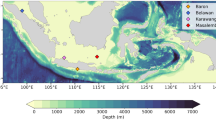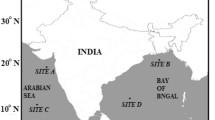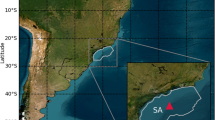Abstract
Effective wave height prediction is crucial for ocean development, marine planning, and other ocean-related projects in coastal areas. A novel hybrid ARIMA-LSTM model is proposed, combining the strengths of Autoregressive Integrated Moving Average (ARIMA) in modeling linear relationships and Long Short-Term Memory (LSTM) in capturing non-linear components within time series data. Applied to Hangzhou Bay and Zhoushan Lianghengshan area data, the ARIMA-LSTM model outperforms traditional ARIMA, Support Vector Machine (SVM), LSTM, and Backpropagation (BP) neural network models across different stations, time periods, and typhoon scenarios. This innovative approach provides valuable technical support for accurate short-term effective wave height predictions.










Similar content being viewed by others
Data Availability
All relevant data generated and utilized in this study are available from the first author upon reasonable request.
References
Agrawal JD, Deo MC (2002) On-line wave prediction[J]. Mar Struct 15(1):57–74. https://doi.org/10.1016/S0951-8339(01)00014-4
Bax N, Novaglio C, Maxwell K H, et al (2021) Ocean resource use: building the coastal blue economy[J]. Rev Fish Biol Fish: 1–19. https://doi.org/10.1007/s11160-021-09636-0
Berbić J, Ocvirk E, Carević D et al (2017) Application of neural networks and support vector machine for significant wave height prediction[J]. Oceanologia 59(3):331–349. https://doi.org/10.1016/j.oceano.2017.03.007
Chang CH, Shih HJ, Chen WB et al (2018) Hazard assessment of typhoon-driven storm waves in the nearshore waters of Taiwan[J]. Water 10(7):926. https://doi.org/10.3390/w10070926
Choi H K (2018) Stock price correlation coefficient prediction with ARIMA-LSTM hybrid model[J]. arXiv preprint arXiv:1808.01560. https://doi.org/10.48550/arXiv.1808.01560
Cisneros-Montemayor AM, Cheung WWL, Bodtker K et al (2017) Towards an integrated database on Canadian Ocean resources: benefits, current states, and research gaps[J]. Can J Fish Aquat Sci 74(1):65–74. https://doi.org/10.1139/cjfas-2015-0573
Dave E, Leonardo A, Jeanice M et al (2021) Forecasting Indonesia exports using a hybrid model ARIMA-LSTM[J]. Proced Comput Sci 179:480–487. https://doi.org/10.1016/j.procs.2021.01.031
Elbisy MS (2015) Sea wave parameters prediction by support vector machine using a genetic algorithm[J]. J Coast Res 31(4):892–899. https://doi.org/10.2112/JCOASTRES-D-13-00087.1
Fan D, Sun H, Yao J et al (2021) Well production forecasting based on ARIMA-LSTM model considering manual operations[J]. Energy 220:119708. https://doi.org/10.1016/j.energy.2020.119708
Forristall GZ (1978) On the statistical distribution of wave heights in a storm[J]. J Geophys Res Oceans 83(C5):2353–2358. https://doi.org/10.1029/JC083iC05p02353
Hao W, Sun X, Wang C et al (2022) A hybrid EMD-LSTM model for non-stationary wave prediction in offshore China[J]. Ocean Eng 246:110566. https://doi.org/10.1016/j.oceaneng.2022.110566
James SC, Zhang Y, O’Donncha F (2018) A machine learning framework to forecast wave conditions[J]. Coast Eng 137:1–10. https://doi.org/10.1016/j.coastaleng.2018.03.004
Jin Z, Zuo C, Wang Z (2017) Impact of phase III project of Maji Mountain port on sediment siltation in adjacent sea area[J]. Acta Oceanol Sin 36:111–118. https://doi.org/10.1007/s13131-017-1074-3
Li L, Yuan Z, Gao Y (2018) Maximization of energy absorption for a wave energy converter using the deep machine learning[J]. Energy 165:340–349. https://doi.org/10.1016/j.energy.2018.09.093
Lou R, Lv Z, Dang S et al (2021) Application of machine learning in ocean data[J]. Multimedia Systems:1–10. https://doi.org/10.1007/s00530-020-00733-x
Mahjoobi J, Mosabbeb EA (2009) Prediction of significant wave height using regressive support vector machines[J]. Ocean Eng 36(5):339–347
Malekmohamadi I, Bazargan-Lari MR, Kerachian R et al (2011) Evaluating the efficacy of SVMs, BNs, ANNs and ANFIS in wave height prediction[J]. Ocean Eng 38(2–3):487–497. https://doi.org/10.1016/j.oceaneng.2010.11.020
Savitha R, Al MA (2017) Regional Ocean wave height prediction using sequential learning neural networks[J]. Ocean Eng 129:605–612. https://doi.org/10.1016/j.oceaneng.2016.10.033
Siami-Namini S, Tavakoli N, Namin A S (2019) A comparative analysis of forecasting financial time series using arima, lstm, and bilstm[J]. arXiv preprint arXiv:1911.09512. https://doi.org/10.48550/arXiv.1911.09512
Sun Z, Wang C, Zhong S et al (2019) Numerical simulation of storm surge coupled with wave in Zhoushan fishing port[J]. Mar Sci Bull 38(2):150–158
Thomas TJ, Dwarakish GS (2015) Numerical wave modelling–a review[J]. Aquat Proced 4:443–448. https://doi.org/10.1016/j.aqpro.2015.02.059
Wang W, Tang R, Li C et al (2018) A BP neural network model optimized by mind evolutionary algorithm for predicting the ocean wave heights[J]. Ocean Eng 162:98–107. https://doi.org/10.1253/circj.70.1231
Xu D, Zhang Q, Ding Y et al (2022) Application of a hybrid ARIMA-LSTM model based on the SPEI for drought forecasting[J]. Environ Sci Pollut Res 29(3):4128–4144. https://doi.org/10.1007/s11356-021-15325-z
Yamak PT, Yujian L, Gadosey PK A comparison between arima, lstm, and gru for time series forecasting[C]//Proceedings of the 2019 2nd international conference on algorithms. Comput Artif Intell 2019:49–55. https://doi.org/10.1145/3377713.3377722
Zhang X, Lin P, Gong Z et al (2020) Wave attenuation by Spartina alterniflora under macro-tidal and storm surge conditions[J]. Wetl 40:2151–2162. https://doi.org/10.1007/s13157-020-01346-w
Zhao L, Li Z, Qu L et al (2023) A hybrid VMD-LSTM/GRU model to predict non-stationary and irregular waves on the east coast of China[J]. Ocean Eng 276:114136. https://doi.org/10.1016/j.oceaneng.2023.114136
Acknowledgments
We want to thank all participants of the of the article. We thank the referees and editors for their constructive feedback regarding the initial version of the manuscript.
Funding
This study is financially supported by General Projects of Zhoushan Science and Technology Bureau and the National Natural Science Foundation of China (No. 52101330).
Author information
Authors and Affiliations
Contributions
Conceptualization, W.-C.B.; methodology, W.-C.B.; software, L.-D.S.; validation, W.-C.B.; formal analysis, W.-C.B.; investigation, C.-J.C.; resources, L.-D.S.; data curation, W.-C.B.; writing—original draft preparation, Y.B.; writing—review and editing, W.-C.B.; visualization, W.-C.B.; supervision, L.-D.S.; project administration, L.-D.S.; funding acquisition, L.-D.S. All authors read and agreed to the published version of the manuscript.
Corresponding author
Ethics declarations
Conflict of interest
The authors declare that the research was conducted in the absence of any commercial or financial relationships that could be construed as a potential conflict of interest.
Additional information
Communicated by: H. Babaie
Publisher’s note
Springer Nature remains neutral with regard to jurisdictional claims in published maps and institutional affiliations.
Rights and permissions
Springer Nature or its licensor (e.g. a society or other partner) holds exclusive rights to this article under a publishing agreement with the author(s) or other rightsholder(s); author self-archiving of the accepted manuscript version of this article is solely governed by the terms of such publishing agreement and applicable law.
About this article
Cite this article
Ban, W., Shen, L., Chen, J. et al. Short-term prediction of wave height based on a deep learning autoregressive integrated moving average model. Earth Sci Inform 16, 2251–2259 (2023). https://doi.org/10.1007/s12145-023-01023-6
Received:
Accepted:
Published:
Issue Date:
DOI: https://doi.org/10.1007/s12145-023-01023-6




